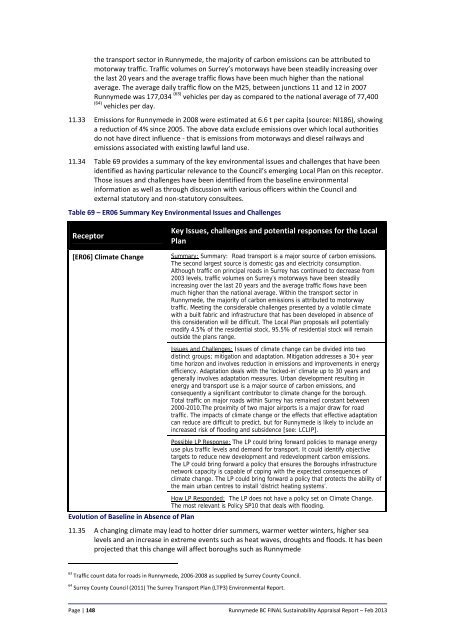DRAFT Sustainability Appraisal Report for the Emerging Local Plan ...
DRAFT Sustainability Appraisal Report for the Emerging Local Plan ...
DRAFT Sustainability Appraisal Report for the Emerging Local Plan ...
Create successful ePaper yourself
Turn your PDF publications into a flip-book with our unique Google optimized e-Paper software.
<strong>the</strong> transport sector in Runnymede, <strong>the</strong> majority of carbon emissions can be attributed to<br />
motorway traffic. Traffic volumes on Surrey’s motorways have been steadily increasing over<br />
<strong>the</strong> last 20 years and <strong>the</strong> average traffic flows have been much higher than <strong>the</strong> national<br />
average. The average daily traffic flow on <strong>the</strong> M25, between junctions 11 and 12 in 2007<br />
Runnymede was 177,034 (63) vehicles per day as compared to <strong>the</strong> national average of 77,400<br />
(64) vehicles per day.<br />
11.33 Emissions <strong>for</strong> Runnymede in 2008 were estimated at 6.6 t per capita (source: NI186), showing<br />
a reduction of 4% since 2005. The above data exclude emissions over which local authorities<br />
do not have direct influence ‐ that is emissions from motorways and diesel railways and<br />
emissions associated with existing lawful land use.<br />
11.34 Table 69 provides a summary of <strong>the</strong> key environmental issues and challenges that have been<br />
identified as having particular relevance to <strong>the</strong> Council’s emerging <strong>Local</strong> <strong>Plan</strong> on this receptor.<br />
Those issues and challenges have been identified from <strong>the</strong> baseline environmental<br />
in<strong>for</strong>mation as well as through discussion with various officers within <strong>the</strong> Council and<br />
external statutory and non‐statutory consultees.<br />
Table 69 – ER06 Summary Key Environmental Issues and Challenges<br />
Receptor<br />
[ER06] Climate Change<br />
Key Issues, challenges and potential responses <strong>for</strong> <strong>the</strong> <strong>Local</strong><br />
<strong>Plan</strong><br />
Summary: Summary: Road transport is a major source of carbon emissions.<br />
The second largest source is domestic gas and electricity consumption.<br />
Although traffic on principal roads in Surrey has continued to decrease from<br />
2003 levels, traffic volumes on Surrey’s motorways have been steadily<br />
increasing over <strong>the</strong> last 20 years and <strong>the</strong> average traffic flows have been<br />
much higher than <strong>the</strong> national average. Within <strong>the</strong> transport sector in<br />
Runnymede, <strong>the</strong> majority of carbon emissions is attributed to motorway<br />
traffic. Meeting <strong>the</strong> considerable challenges presented by a volatile climate<br />
with a built fabric and infrastructure that has been developed in absence of<br />
this consideration will be difficult. The <strong>Local</strong> <strong>Plan</strong> proposals will potentially<br />
modify 4.5% of <strong>the</strong> residential stock, 95.5% of residential stock will remain<br />
outside <strong>the</strong> plans range.<br />
Issues and Challenges: Issues of climate change can be divided into two<br />
distinct groups; mitigation and adaptation. Mitigation addresses a 30+ year<br />
time horizon and involves reduction in emissions and improvements in energy<br />
efficiency. Adaptation deals with <strong>the</strong> ‘locked-in’ climate up to 30 years and<br />
generally involves adaptation measures. Urban development resulting in<br />
energy and transport use is a major source of carbon emissions, and<br />
consequently a significant contributor to climate change <strong>for</strong> <strong>the</strong> borough.<br />
Total traffic on major roads within Surrey has remained constant between<br />
2000-2010.The proximity of two major airports is a major draw <strong>for</strong> road<br />
traffic. The impacts of climate change or <strong>the</strong> effects that effective adaptation<br />
can reduce are difficult to predict, but <strong>for</strong> Runnymede is likely to include an<br />
increased risk of flooding and subsidence [see: LCLIP].<br />
Possible LP Response: The LP could bring <strong>for</strong>ward policies to manage energy<br />
use plus traffic levels and demand <strong>for</strong> transport. It could identify objective<br />
targets to reduce new development and redevelopment carbon emissions.<br />
The LP could bring <strong>for</strong>ward a policy that ensures <strong>the</strong> Boroughs infrastructure<br />
network capacity is capable of coping with <strong>the</strong> expected consequences of<br />
climate change. The LP could bring <strong>for</strong>ward a policy that protects <strong>the</strong> ability of<br />
<strong>the</strong> main urban centres to install ‘district heating systems’.<br />
How LP Responded: The LP does not have a policy set on Climate Change.<br />
The most relevant is Policy SP10 that deals with flooding.<br />
Evolution of Baseline in Absence of <strong>Plan</strong><br />
11.35 A changing climate may lead to hotter drier summers, warmer wetter winters, higher sea<br />
levels and an increase in extreme events such as heat waves, droughts and floods. It has been<br />
projected that this change will affect boroughs such as Runnymede<br />
63 Traffic count data <strong>for</strong> roads in Runnymede, 2006‐2008 as supplied by Surrey County Council.<br />
64 Surrey County Council (2011) The Surrey Transport <strong>Plan</strong> (LTP3) Environmental <strong>Report</strong>.<br />
Page | 148 Runnymede BC FINAL <strong>Sustainability</strong> <strong>Appraisal</strong> <strong>Report</strong> – Feb 2013

















